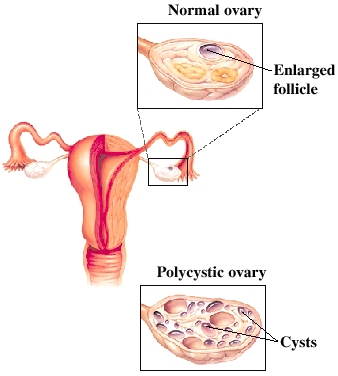Polycystic Ovary Syndrome
Polycystic Ovary Syndrome
Polycystic ovary syndrome (PCOS) causes harmless, small cysts in the ovaries and other symptoms. PCOS is caused by certain hormones being out of balance. The word “syndrome” means a group of symptoms. Women with PCOS may have no periods, irregular periods, or very long periods.

Your ovaries
Women store their eggs in their ovaries. Each egg is in a capsule called a follicle. Normally during the reproductive years, one follicle grows to produce a mature egg each month. This egg is released during ovulation and the follicle dissolves.
Hormones out of balance
With polycystic ovary syndrome (PCOS), the hormones that control ovulation are out of balance. These include estrogen, progesterone, and androgen. As a result, ovulation may not occur. Instead, the follicle stays enlarged. This is a fluid-filled sac called a cyst. Over time, the ovaries fill with many small cysts. This is why they are called “poly” or many “cystic” ovaries. In some women, the ovaries also make too much androgen.
Women with PCOS may also have one or more of these symptoms:
-
Acne
-
Hair growth on the face and other parts of the body
-
Patches of thickened, velvety, darkened skin called acanthosis nigricans
-
Trouble getting pregnant (fertility problems)
-
Weight gain, especially around the waist
Women with PCOS are also at increased risk of developing cancer of the uterine lining, diabetes, and heart disease.
Updated:
March 16, 2019
Sources:
Polycystic Ovary Syndrome (PCOS) FACT SHEET. American Society for Reproductive Medicine.
Reviewed By:
Goode, Paula, RN, BSN, MSN,Sacks, Daniel, MD, FACOG